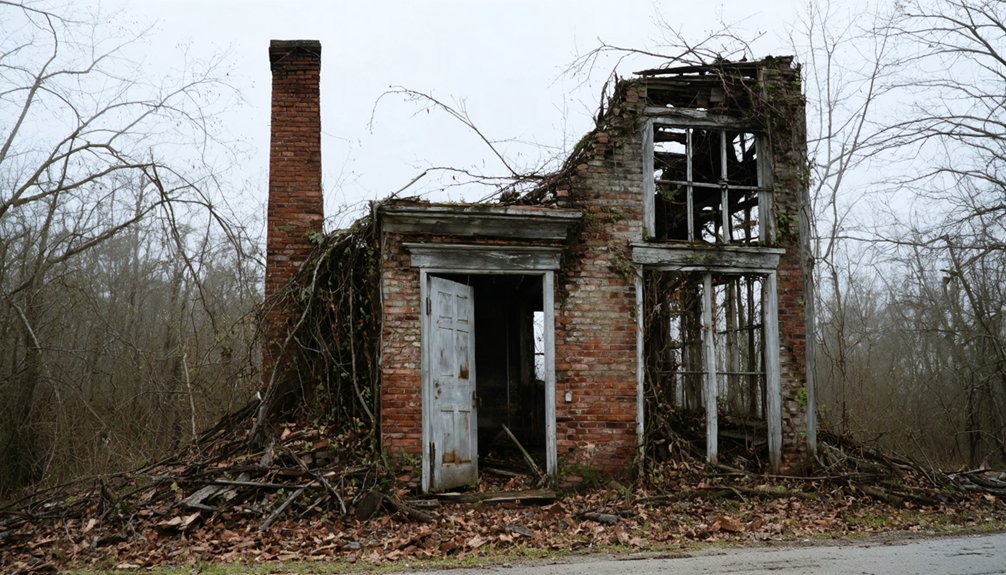You’ll find Houston, Alabama’s ghost town nestled along the Black Warrior River, where it once served as Winston County’s seat from 1858 to 1884. The town flourished as a bustling administrative center with a courthouse, jail, and essential cotton trade supported by steamboat traffic. After losing its county seat status to Double Springs, Houston rapidly declined into abandonment. Today, scattered remnants and archaeological discoveries tell a fascinating tale of this forgotten community’s rise and fall.
Key Takeaways
- Houston was established as Winston County’s first county seat in 1858 but lost this status to Double Springs in 1884.
- The town prospered as a cotton trading hub with steamboat access before declining after the Civil War and railroad development.
- After losing county seat status, Houston rapidly transformed into a ghost town as businesses and administrative functions relocated.
- Archaeological discoveries reveal domestic and industrial artifacts from the 1920s, including mining tags and personal items.
- The abandoned site is now accessible via forested roads, featuring scattered remnants and overgrown terrain from its prosperous past.
The Rise of a County Seat (1858-1884)
As Winston County emerged from its original designation as Hancock County in 1858, the establishment of Houston as the county seat marked a pivotal shift in the region’s development.
You’ll find that Houston’s historical significance stemmed from a democratic process where voters chose between two proposed sites, solidifying the town’s administrative role.
The Byler Road connection provided vital transportation access to both the Tennessee Valley and Tuscaloosa regions, enhancing Houston’s importance as an administrative center.
The community dynamics of this era centered around Houston’s newfound status as the political and legal hub.
You can trace the town’s importance through its courthouse and jail infrastructure, where county commissioners oversaw critical functions like elections for sheriff, clerk, and tax collector.
The courthouse became the heart of local governance, managing judicial proceedings and centralizing county administration away from older centers in Walker and Blount counties. A tragic chapter in Houston’s history unfolded when raiders killed Curtis, the Probate Judge, and stole the county’s money and salt in 1864.
This arrangement would last until 1884.
Life in 19th Century Winston County
Life in Houston, Winston County’s seat from 1858 to 1884, centered around the county courthouse where you’d find officials managing local records, settling disputes, and conducting essential government business.
Your daily interactions would’ve taken place within a tight-knit farming community, where most residents worked small subsistence plots and gathered at local churches like Clear Creek Baptist for both worship and social functions. The area’s demographics showed a population of 3,450 white residents who primarily maintained small farms. Most settlers established close ties with the native tribes, sharing hunting grounds with Cherokee, Creek, and Chickasaw peoples.
You’d have witnessed the stark contrast between Houston’s role as a center of local government and the surrounding countryside’s modest agricultural life, where families struggled to make ends meet on the region’s poor, shallow soil.
County Seat Daily Operations
While Houston served as Winston County’s first seat of government from 1850, daily operations centered around its rough-hewn log courthouse where a three-member commission managed the county’s affairs.
You’d find justices of the peace and circuit judges periodically traveling to Houston to handle court logistics, from settling land disputes to collecting debts. Daily governance involved maintaining public records, levying taxes, and addressing the needs of a growing population.
If you’d visited during court terms or market days, you’d have encountered farmers and merchants gathering near Brushy Creek for trade. The courthouse wasn’t just a legal center – it served as the hub of civic life, though you’d have faced challenging travel conditions on unpaved roads to reach it. The area later became one of several Winston Counties in the United States requiring clear geographical distinction.
A devastating courthouse fire in the late 19th century would eventually lead to the county seat’s relocation to Double Springs. Special taxes after 1865 funded necessary improvements to handle increasing administrative demands.
Rural Community Social Structure
The social fabric of Winston County in the 1800s took shape around its challenging mountain terrain and scattered settlements. You’d find tight-knit community dynamics built on Protestant churches, small farms, and mutual assistance between neighbors. Family networks strengthened through intermarriage among settlers who’d arrived from Georgia, the Carolinas, Tennessee, and Virginia.
Local kinship networks proved essential for survival, as you’d need help with farming, road-building, and other communal tasks. Early settlers relied heavily on the Byler Road to connect their isolated communities. Dr. Donald Dodd’s Images of America series captures these historical community connections.
Churches and schools served as social anchors, though formal education remained limited with just four schools serving 74 students by 1850. Life centered on self-sufficiency and cooperation, with social events revolving around church gatherings, school functions, and shared labor.
The rugged landscape fostered a spirit of independence while reinforcing the need for strong community bonds.
Architecture of the Historic Houston Jail
Built in 1868 using hand-hewn hardwood logs, Houston’s historic jail stands as Alabama’s only surviving log jail and one of the oldest penal structures in the South.
The jail’s architecture demonstrates frontier-era security innovations through its 20×20 foot design, featuring interlocking logs with half-notched corners and a raised fieldstone foundation. The structure was converted to serve as a residence for the poor in 1933. The building represents a crucial piece of history as the final public building remaining from Houston’s time as the Winston County seat.
Ingenious pioneer craftsmen created this secure lockup using precision-cut logs and strategic architectural features to ensure maximum prisoner containment.
You’ll find these remarkable security features throughout the structure:
- Multi-layered 1.5-inch plank doors built at angles to prevent break-ins
- Interior walls covered with boards secured by handmade iron nails placed every inch
- Small, iron-barred windows and closely-spaced ceiling logs to prevent escape
The jail’s historical significance earned it a place on the National Register of Historic Places in 1975, and it remains a rare example of 19th-century penal architecture that showcases rural frontier justice systems.
Daily Operations and Governance
Given the lack of specific historical documentation about Houston, Alabama, you won’t find detailed records of its administrative systems or law enforcement practices.
While many Alabama ghost towns maintained county sheriffs and basic jail operations during their active periods, we can’t confirm specific governance structures that may have existed in Houston.
The absence of concrete historical evidence about Houston’s daily operations means that any discussion of its law enforcement or jail management would be purely speculative.
County Administration Systems
Since its establishment in 1903, Houston County’s administration has operated under a five-member County Commission that serves as both legislative and administrative authority.
You’ll find this system of county governance centered in Dothan, where commissioners oversee vital operations and electoral processes from the Administration Building.
The commission’s responsibilities include:
- Managing budget allocations and daily operations
- Overseeing law enforcement and justice system support
- Administering elections and voter registration systems
You’re served by a complex network of independent offices, including elected positions like sheriff and probate judge, which maintain checks and balances in the system.
This structure guarantees that you’ve got access to essential services while preserving administrative independence across the county’s 577 square miles, from its rural areas to urban centers.
Jail Management Practices
The Houston County Jail operates under rigorous management practices that shape its daily functions and governance structure.
You’ll find a highly organized system where jail operations follow strict schedules, from wake-up calls to lights-out procedures. The facility maintains control through systematic headcounts and supervised inmate movement throughout the day.
Watch Commanders and supervisors oversee security protocols, conducting regular inspections and maintaining surveillance systems. They’ll coordinate inmate programs, including work assignments in kitchen, maintenance, and laundry duties.
You’ll notice a clear chain of command, where the Jail Manager holds ultimate responsibility while supervisors direct daily activities. Staff training guarantees consistent policy enforcement, while systematic searches control contraband.
Recreation periods and structured activities help manage inmate behavior, supporting both security and rehabilitation goals.
Local Law Enforcement
While serving a jurisdiction of 587 square miles, the Houston County Sheriff’s Office maintains broad law enforcement coverage for approximately 109,000 residents through strategically organized patrol divisions.
Under Sheriff Donald Valenza’s leadership since 2014, you’ll find deputies working alternating day and night shifts to guarantee continuous community safety and local crime prevention.
The department’s commitment to constitutional principles and public service is evident through:
- Highly trained K-9 units featuring Belgian Malinois and bloodhound dogs for drug detection and tracking
- Deputies equipped with advanced technology including mobile computers and digital recording systems
- Thorough training programs accredited by APOSTC and ongoing professional development
You’ll see deputies in tan and brown uniforms patrolling in black vehicles marked with gold sheriff stars, representing their dedication to maintaining order through community-focused law enforcement.
Economic Activities and Trade
During its heyday, Houston, Alabama thrived as a bustling port town where cotton reigned supreme. You’d find steamboats regularly maneuvering the Alabama River, transporting cotton bales to major markets like Mobile.
When the railroad arrived in 1859, it transformed the town’s trade routes and expanded its commercial reach.
The Civil War dealt a devastating blow to Houston’s economy. Confederate forces commandeered the rail lines and converted cotton warehouses into military prisons.
The agricultural decline accelerated as trade infrastructure crumbled, and a catastrophic flood in 1865 destroyed what remained of the town’s commercial facilities.
The loss of its state capital status, combined with severe population decline, sealed Houston’s economic fate.
Today, you’ll find only ruins at Old Cahaba Archaeological Park, reflection of a once-prosperous trading hub.
The Relocation and Abandonment

You’ll find Houston’s fate was sealed when it lost its county seat status to Double Springs in 1884 through a citizen election.
The town’s importance quickly diminished as administrative functions, businesses, and residents moved to areas with better transportation access and economic opportunities.
Following the decline of river commerce and the rise of railroads, Houston’s remaining population gradually disappeared, leaving behind only scattered remnants of its former prominence.
County Seat Status Lost
As towns across Alabama faced shifting economic and political dynamics in the 19th century, the loss of county seat status often spelled doom for once-prosperous communities.
When towns lost their administrative importance, you’d witness a rapid transformation into a ghost town as government functions relocated and businesses followed. The historical significance of these changes rippled through local economies, leading to widespread abandonment.
- County seat relocations required legislative approval and new courthouse construction
- Government offices, legal services, and related businesses moved to new administrative centers
- Property values plummeted as residents and merchants sought opportunities elsewhere
The process stripped former county seats of their essential economic drivers, leaving behind empty buildings and declining populations.
Transportation changes, particularly railroad developments, further isolated these communities, accelerating their descent into obscurity.
Reasons For Moving Away
The relocation and abandonment of Houston, Alabama unfolded through multiple interconnected factors that reshaped the town’s destiny.
You’ll find that economic migration played a decisive role as key industries dried up – from declining mining operations to the closure of pig iron furnaces that couldn’t compete with Birmingham’s superior production.
The town’s isolation deepened when transportation shifts bypassed the area, cutting off crucial market connections.
Without economic diversification, you’d have seen how the community decline accelerated. Young families left for urban opportunities while essential services vanished – the post office closed, commerce dwindled, and infrastructure crumbled.
Natural resource depletion, including exhausted soil and minerals, further undermined Houston’s sustainability.
These combined pressures ultimately forced residents to seek better prospects elsewhere.
Population Gradually Disappeared
Once Houston lost its county seat status to Double Springs in 1884, the town’s population began a steady decline that would span several decades.
The community migration patterns revealed how residents steadily moved away to nearby towns with better opportunities and services. Population trends showed a consistent exodus as Houston’s importance diminished without its administrative role.
Key factors that drove people away included:
- Closure of the courthouse and loss of government jobs
- Shift in transportation routes that diverted trade elsewhere
- Lack of new industries or infrastructure development
You’d have found Houston largely abandoned by the early 1900s, with most business and governmental activities relocated.
The town’s transformation into a ghost town was complete by mid-century, marking the end of what was once a vibrant community.
Preservation Efforts Through Time

While many ghost towns fade into obscurity, Houston, Alabama’s preservation efforts have created a lasting historical legacy through strategic programs and community involvement.
You’ll find various preservation initiatives working together, from state-supported programs to grassroots community engagement. The Old Cahawba Archaeological Park maintains historic structures and provides guided tours, while local historical societies organize volunteer events and fundraising drives.
Despite preservation challenges like natural decay and limited funding, you can explore the town’s history through modern technological solutions, including virtual tours and mobile apps.
Modern technology brings Houston’s history to life, overcoming preservation hurdles through innovative virtual tours and digital access.
State preservation policies have helped stabilize remaining structures, though urban development and weather continue to threaten historic sites. Through partnerships with schools and civic organizations, Houston’s heritage remains accessible for future generations to discover.
Archaeological Discoveries and Studies
Recent archaeological discoveries along Houston’s riverbeds have revealed a rich tapestry of early 20th-century life in this Alabama ghost town. Through artifact analysis, you’ll find evidence of both domestic and industrial activities, with items ranging from 1920s ketchup bottles to mining equipment scattered throughout the waterways.
- Mudlarking efforts have uncovered personal items like marbles, fishing gear, and mysteriously discarded prosthetic limbs, painting a vivid picture of community life.
- Metal detecting has revealed period-appropriate buckles, mining tags, and industrial hardware that confirm the town’s coal mining heritage.
- Systematic recovery efforts have located evidence of major structures, including brick fragments from what may have been schools or hospitals near the riverbanks.
These finds continue to illuminate Houston’s fascinating evolution from bustling mining town to abandoned settlement.
Visiting the Ghost Town Today

Although Houston’s ghost town remains lie hidden within Winston County’s rural landscape, you’ll find the site accessible through careful navigation of forested back roads. For successful ghost town exploration, bring GPS navigation or local maps, as formal signage is limited.
Hidden in Winston County’s wooded backroads, Houston’s ghost town beckons adventurous souls willing to navigate its unmarked paths.
While public access is generally permitted, it’s wise to verify local regulations before your visit.
When you arrive, you’ll need to park along the roadside, as there aren’t designated parking facilities. The site’s historical significance is evident in scattered remnants, though nature has reclaimed much of the area.
You’ll discover building foundations and old road traces beneath the vegetation. Be prepared to walk through overgrown terrain to explore what’s left of this abandoned settlement.
Remember to document your findings while respecting the site’s fragile condition.
Legacy in Alabama’s Rural History
As a tribute to Alabama’s evolving rural landscape, Houston’s legacy endures through its significant role as Winston County’s seat from 1858 to 1884.
When you explore ghost town experiences like Houston’s, you’ll discover how rural community narratives shaped Alabama’s development and decline.
- Houston exemplifies the vulnerability of towns dependent on political designations, showing how quickly fortunes can change.
- The town’s transformation from county seat to ghost town mirrors the broader pattern of rural depopulation across Alabama.
- Its architectural remnants serve as silent witnesses to the region’s past prosperity and subsequent economic shifts.
You can trace Houston’s story through surviving structures and historical records, offering valuable insights into how administrative centers influenced local power structures and community identity in 19th-century rural Alabama.
Frequently Asked Questions
Were There Any Notable Crimes or Prisoners Held in the Houston Jail?
Picture a blank history book – that’s what you’ll find about notorious inmates or jail history in Houston. There’s no documented evidence of any notable prisoners or crimes during its county seat era.
What Happened to Houston’s Original Government Records and Documents?
You won’t find many missing documents since Houston County has preserved its original government records from 1903 onward, with no major archival challenges or disasters affecting their courthouse holdings.
Did Any Prominent Families From Houston Establish Dynasties Elsewhere?
You’ll find the Manasco family created lasting legacies in Walker and Winston Counties, while other Houston families established historical connections through migration patterns across northwestern Alabama’s developing communities.
Were There Any Significant Natural Disasters That Contributed to Houston’s Decline?
You won’t find natural disasters behind Houston’s downfall. Instead, economic decline sealed its fate – the loss of its county seat status and post office closure in the late 1800s proved decisive.
What Native American Tribes Originally Inhabited the Houston Area?
You’ll find the Alabama-Coushatta tribes were prominent Native Tribes in Houston’s area, establishing settlements in the Big Thicket region. They preserved their cultural heritage while supporting Texas during its independence.
References
- https://ahc.alabama.gov/properties/cahawba/cahawba.aspx
- https://www.tripadvisor.com/ShowUserReviews-g30754-d3405413-r702542512-Old_Cahawba_Archaeological_Park-Orrville_Alabama.html
- https://digitalalabama.com/article/alabama-ghost-towns/page/2
- https://www.onlyinyourstate.com/trip-ideas/alabama/ghost-towns-road-trip-al
- https://www.hmdb.org/m.asp?m=182919
- https://www.allacrosstexas.com/texas-ghost-town.php?city=Alabama
- https://www.texasescapes.com/EastTexasTowns/Alabama-Texas.htm
- https://en.wikipedia.org/wiki/List_of_ghost_towns_in_Alabama
- http://www.freestateofwinston.org/houstonhistory.htm
- http://www.freestateofwinston.org/factandfiction.htm



